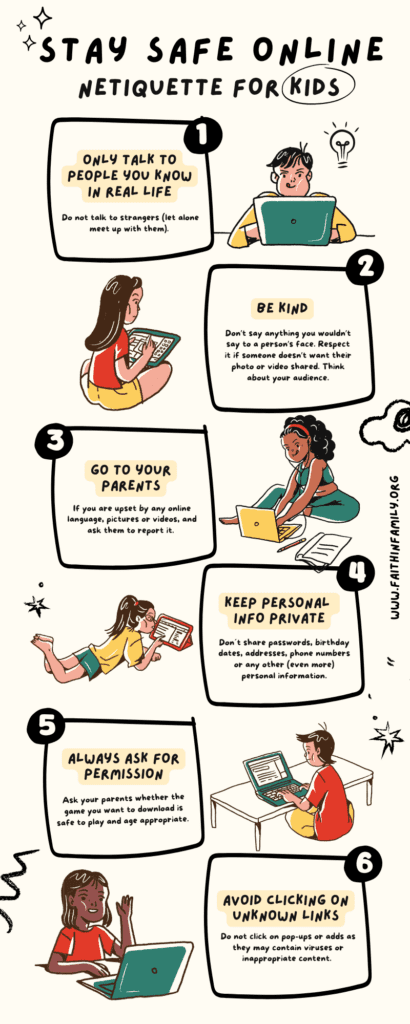
It is estimated that about 1 in 8 children worldwide were sexually exploited by online abuse in 2023. As our society changes, more and more children are victimized by online predators. What and our children need is to be aware of this and have a plan. Read this article to find out how to protect your child from these online predators, and learn how to respond in case a predator does target your child.
Unfortunately the question is not if your child will be approached by online predators, the question is when… & What will be their response?
How Online Predators Use Social Media and Other Online Platforms
Of course, the last thing we want to do is to put ourselves in the shoes of an online predator. But in order to best protect our children from them, we need to know how they think.
There are four types of online predators:
- Gatherers, who collect media containing photographic or video pornography
- Producers, who distribute child pornography
- Talkers, who target victims in chat rooms
- Voyagers, their aim is to meet their victim in person
89% of predators find their victims in chatrooms and instant messaging. Their contact with children is in most cases a grooming method, instead of a goal in itself. This makes sense when you take into account that as much as 85% of online predators are hands-on child abusers… Their most likely victims are females aged 12-15.
According to statistics 82% of child sex crimes start with social media contact. In 33% of cases, predators ask children to send sexually explicit photos of themselves. In 23% of cases they send unprompted sexually explicit photos of themselves.
These predators gain the trust of children by complimenting and praising them, by so called shared interests and being caring. They lie about their identity, pretending to be somebody that can be trusted.
We know that the most common way that children are being targeted by online predators is by unwanted sexual questions and forced images. 75% of children that are sexually approached online did not tell their parents about it…
Educate Your Child on Online Safety to Protect Them From predators.
As we said, chances are that your child is going to be approached by online predators through social media, online games, chat rooms etc. Preventing them from engaging into contact with them is the best you can do.
You do this by establishing ongoing, open communication. How to do that? We made a list of tips and conversation starters per age group in this article.
Creating a Safe Online Environment
Although your child is now alert to potential dangers, you as a parent can of course lend a hand. You do this by creating safe conditions wherein they can go online.
Keep an eye on your child’s online interactions. Here are some tools and apps you can install that will help monitor their activity.

Use Parental Control Software
By using parental control software, you can block harmful apps and websites to keep your child safe. These apps can detect severe bullying or self-harm situations. They also offer device tracking for peace of mind. Besides, they help parents monitor screen time, to cut down the time everyone spends on their devices. While there is many software available from third parties, you can also choose for Google Family Link, Microsoft Family Safety or Apple Parental Controls; since they already have your data anyway ;).
Keep in mind that installing parental control software can cause your child to feel like you’re spying on them, if without their consent. That is why we advise you to install this software when your child is young. This way he or she will be more used to you keeping an eye out for them as they grow up.. Remain open and honest about your intentions and deeds. This way they will be more likely to understand where you’re coming from. Of course your child will need to learn to deal with the ‘real world’ independently at some point.
Setting Up Privacy Settings for Your Child
To protect and empower your child at the same time, look at safe use of social media together. Talk about privacy settings on apps, and passwords.
On this website you will find very specific tips on setting up privacy settings for every popular social media platform, any device or search engine. It can be necessary to regularly review these settings, as they can change whenever you update the app.
A few quick tips are, of course, to set all settings to private and to not share any geolocation. This way you can protect your children from any risk of physical harm, stalking, or cyberbullying.
While cyberflashing doesn’t count as social media, it is worth mentioning. By leaving your child’s AirDrop or Bluetooth settings on active, they can be cyberflashed. This means that someone who is nearby can send them explicit pictures or content, without their consent. They don’t even need their telephone number. It is very disturbing that these images can appear on screen, before the transfer is accepted. This is a terrible invasion of privacy and can be deeply traumatizing for a child.
So turn AirDrop and Bluetooth off as a default. Explain the dangers of cyberflashing to your child, and make clear they should never accept files from strangers.
Child Friendly Websites or Apps
It is good to offer alternatives to your child so they can entertain themselves in ways that do not threaten their safety. Contrary to what you might think, YouTube Kids is not safe for children at all times. Be sure to adjust privacy settings so that they are not exposed to violent or harmful content.
Here is a list of examples of games per age, you can let your child play confidently. Many of these games stimulate your child’s development, creativity and gets them into physical action.
Additionally, there are apps especially for children that allow them to safely develop skills that will help them in their future. Of course while having some fun along the way!
Make Family Agreements About Online Safety Together
Another way to create a safe online environment for your child, especially if you have older kids, is to make agreements about online usage together. Talk together about how you can promote positive online activities, and discourage excessive screen time. Again, make sure you find the balance between respecting your child’s privacy and protecting them online. Brainstorm together with your older child on how to do this. Tell them their privacy is important to you, but their safety too. You might be surprised at the great ideas your t(w)een brings in!
Recognizing Warning Signs
So how can we as parents make sure that our child does not end up as one of the statistics mentioned at the start of this article? Unfortunately we can never be 100% sure. First and foremost we need to keep our children in prayer! Also, we need to, at all times, keep investing in a trust relationship with our children, so that they will always feel comfortable enough with us to keep us in the loop.
If you notice that your child is suddenly acting secretive about his or her online activities, suddenly changes its device usage patterns or receives gifts or packages from unknown sources, be alert.
Signs of grooming are hard to spot because sexual predators usually tell children to stay silent and not speak out about it. Try showing this video to your tween, teen or young adult to get them to open up.
Responding to (Suspected) Predatory Behavior
Open the conversation with your child about your observations. Tell them why you want to talk to them, and tell them in a kind way that you love them and want to protect them. Share a statistic about children that are victimized by online predators, and tell your child you want to make sure it is not them. Ask your child if he or she can take your worries away.
If your worries are taken away, that is that. Thank them for their transparency and give them a bear hug.
If your worries are not taken away, read on…
Steps to Take if Your Child is Being Targeted
1. First take a deep breath, and keep calm.
Your child needs you as a parent to be strong in this situation. Save your moment to ventilate for when the necessary first steps have been taken to ensure your child’s safety.
2. Prevent victim blaming.
Don’t ask your child whether they said clearly enough that they didn’t want it. Also don’t tell them they could’ve just walked away. Making these comments has a negative effect on your child’s recovery. Sometimes even worse than the event itself. Your child can come to believe that the whole situation is their own fault. Now they also have to deal with extra feelings of guilt and shame. Make clear that your child is in no way to be blamed. Tell them that the perpetrator is the only one who should have done something different.
3. Listen to your child.
This point is especially important if your child is a teenager or young adult. Since most victims are aged 12-15, chances are this is the case. Before you turn to the police, ask your child what he or she would like to happen. Maybe you won’t be able to grant every request, but your child needs to feel heard by you now.
Ask your child questions like: What would help you now? Do you want me to hear you out? Would you like me to give you advise? Do you want me to help you look for help? or Shall we call the police together?
Make clear what needs you can meet, and where you draw the line in view of his or her safety.
4. Understand the context, and document the evidence.
This is crucial for making a good report. Take screenshots of online conversations, inappropriate questions, pictures and the reactions that were placed.
If dealing with sexting, determine where they are posted, and who posted them.
If dealing with online grooming, find out who your child is talking to. When necessary, ask others like their friends or teacher if they might know who is trying to groom your child.
5. Reach out to reestablish safety.
If dealing with sexting, reach out to the person who shared the photos. Politely but firmly ask them to take the pictures offline. Explain the concerns you have about your child’s privacy and safety. Do they refuse? Then report the content to the platform where it was posted. Most platforms have policies against sharing inappropriate images of minors. They will take them down.
If dealing with online grooming, don’t reach out to the perpetrator. Immediately contact the police or the authority in your country that deals with issues on this topic, and report to them.
Notify school authorities or others if it will benefit the situation. You may be able to protect others by informing them of what happened. You can, of course, ask them to handle the situation anonymously.
6. Seek legal advice, if necessary.
In Summary
Hopefully this article has given some insight into the ways predators operate, and how you can protect your precious child from them. Also, we hope we have given some ideas on how to be there for your child in the whole process.
Remember that you as a parent have a crucial role in protecting your child from the online dangers. Other organizations or people might help out a bit here and there. Still, us fathers and mothers are responsible in the end, and we cannot definitely fully rely on others to take on this task.
We encourage all parents to stay informed and involved in your child’s digital life.
Share Your Tips & Read More
How would you protect your child from online predators? Do you have a good tip that we haven’t mentioned in this article? Please share your advice with other parents in the comments, so that we can all benefit from each other’s experiences!
If you want to educate yourself more on how to protect your child from online predators, check out Child rescue coalition. On their website you will find many blogs directed to parents.
